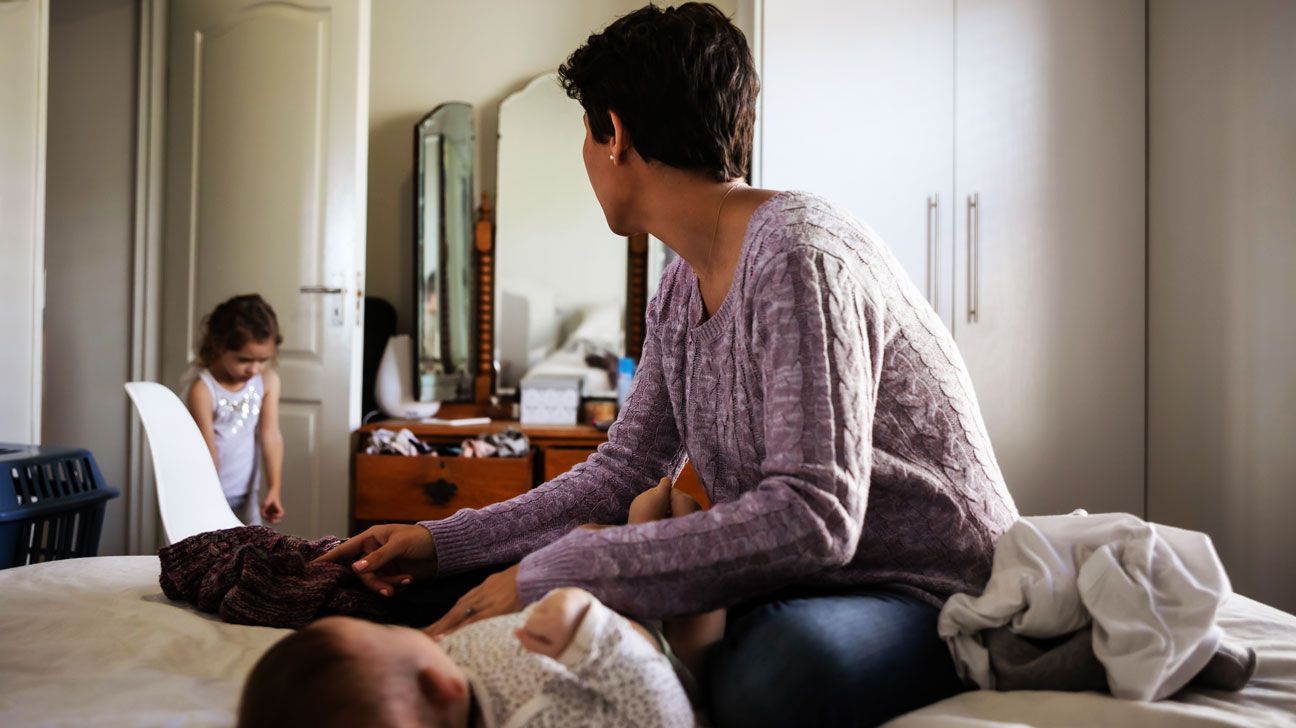The baby blues, or feeling down, tired, and overwhelmed after giving birth, are common. However, if the feelings worsen or linger for weeks or months, you might be living with postpartum depression.

Pregnancy is physically and mentally demanding. Feeling some anxiety, unhappiness, or overwhelm is natural when your life is in a state of flux and you’re wading through unfamiliar territory. Your hormones are fluctuating, your body is going through drastic changes, and everything you do revolves around having a baby.
Many birthing parents experience the baby blues after pregnancy. These mild and brief periods of mood fluctuations often include bouts of crying, unhappiness, and irritability.
But for some parents, negative thoughts and feelings go beyond what’s expected. Sometimes, those feelings become constant and intense enough to impair daily function. If this sounds like what you’re experiencing, you may be living with postpartum depression (PPD).
Learn more about postpartum depression.
While the baby blues and postpartum depression (PPD) refer to experiences of low mood after giving birth, they aren’t the same.
The baby blues, also known as postpartum blues, consist of mild mood fluctuations that occur within the first few days and up to 2 weeks after birth. They’re considered the natural result of the hormonal changes, routine shifts, and physical demands that come with having a baby.
As many as 85% of all new mothers experience the baby blues. They resolve on their own and don’t affect your daily function.
Common symptoms include:
- mild changes in mood
- restlessness
- feeling overwhelmed, unhappy, or anxious
- crying without an apparent reason
- loss of appetite
- difficulty sleeping
Postpartum depression, included under the umbrella of perinatal depression, is a mental health condition. Its symptoms are persistent, present most of the day, every day. Like other mental health conditions, PPD is significantly disruptive.
Unlike the baby blues, PPD can occur up to 1 year after giving birth. It lasts longer and may require medical treatment. Symptoms of PPD are more severe than those seen in the baby blues and can include all of the symptoms of major depressive disorder (MDD), as well as:
- feelings of detachment from your baby
- excessive doubts about caring for your baby
- thoughts of hurting yourself or your baby
The baby blues and PPD can feature:
- low mood
- random bouts of crying
- feelings of overwhelm
- anxiety, fear, or guilt
- sadness and unhappiness
- appetite changes
- sleep disturbance
The baby blues and PPD are distinguished by the range and severity of their symptoms, speed of onset, and duration.
A doctor can determine whether your mood symptoms align with the baby blues or if indicate a more serious condition, like PPD.
To make this assessment, your doctor will ask about your symptoms. They’ll want to know when you started experiencing them, how often you have them, and if they disrupt your routine.
PPD has specific diagnostic criteria as outlined in the Diagnostic and Statistical Manual of Mental Disorders, 5th edition, text revision (DSM-5-TR). In the DSM-5-TR, PPD is diagnosed under the same guidelines as MDD with the specifier of “with peripartum onset.”
To receive a PPD diagnosis, you must experience 5 or more symptoms of MDD beginning immediately before, during, or after childbirth (the peripartum period) and lasting 2 weeks or longer, according to the DSM-5-TR.
The baby blues do not require medical treatment. They resolve on their own, often within several days, though they may last as long as 2 weeks.
You can manage the baby blues by:
- learning stress management and relaxation techniques
- delegating responsibilities and accepting help
- making time for self-care breaks
- connecting with other parents who share your experience
- resting and sleeping as much as possible
- keeping up with healthy lifestyle habits
- journaling
Like other depressive disorders, PPD is managed through psychotherapy, medications, and lifestyle modifications.
Psychotherapy, also known as “talk” therapy, can help you identify and change unhelpful patterns of thinking in PPD while also building coping strategies.
Psychotherapy without medication is typically recommended first for birthing parents who are nursing. However, if PPD is severe, antidepressants may be added to therapy to help reduce your symptoms.
Birthing parents experiencing PPD are encouraged to enhance their treatment plans with lifestyle modifications that promote overall well-being, like focusing on quality sleep, eating a balanced diet, and getting daily exercise.
The baby blues will go away within days or a few weeks. The short duration and mild symptoms are two of their defining traits.
PPD can last much longer, especially if left untreated. One
Early treatment may improve PPD recovery times and reduce the severity of symptoms.
What other conditions are associated with postpartum depression?
Symptoms of PPD can co-occur alongside other postpartum conditions such as:
- postpartum anxiety
- postpartum psychosis
- postpartum obsessive-compulsive disorder
- postpartum bipolar disorder
Are the baby blues a mild form of PPD?
The baby blues and PPD are separate conditions, but both experiences fall within the classification of “postpartum mood disorders,” a spectrum of mood-related experiences that occur within the
What are the baby blues also called?
The baby blues are also known as the postpartum blues.
The baby blues and postpartum depression are mood-related experiences that occur shortly after giving birth. They have similar symptoms, but the baby blues are mild and short-lived, and PPD is long lasting and can disrupt daily function.
Focusing on self-care and stress management can help you manage the baby blues, but PPD management may require medications, lifestyle modifications, and guidance from a mental health professional.
